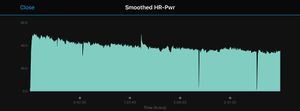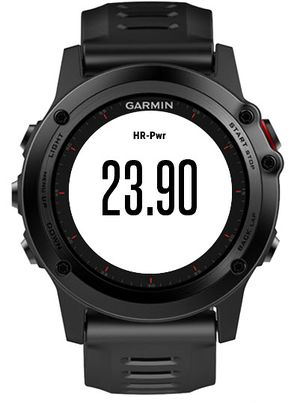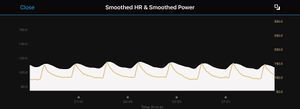HrPwr
HrPwr is the relationship between heart rate, and power output. It can evaluate Running Economy and Heart Rate Drift. HrPwr is easy to implement, and I have published a Connect IQ data field called HrPwr that's available here.
Contents
[hide]1 Setup
You will need a Stryd footpod to estimate power. You'll also need to pair your Stryd footpod as a power meter. This is in addition to having Stryd paired as a footpod to give speed.
2 Background
My initial approach to measuring Running Economy outside of a lab was to use heart rate to estimate the effort and distance covered for the effort. This works okay on the flat, as distance covered is a good measure of effort. However, as anyone who has run hills knows, slope dramatically change effort. The Stryd footpod estimates the power output based on pace and elevation changes, which solves this problem nicely. It also gives the possibility of comparing data from running with cycling, though I've found the Stryd power estimate to be much higher for a given perceived effort than cycling.
3 How to Interpret HrPwr
There are three uses for HrPwr.
- During a run, you can use HrPwr to see Heart Rate Drift. I see this during my long runs, and I can use HrPwr to test how effective my hydration, fueling, and cooling approaches are.
- On a day-to-day basis, HrPwr can detect possible health and fitness issues. I've found that Glycogen depletion can cause a lower HrPwr, as can heat stress. Likewise, my HrPwr is lower at the start of a race because of increased stress, though it settles down as I relax into things. Lower HrPwr sometime shows I'm more fatigued than I realize.
- Over the long term, HrPwr should rise as you become fitter and have better Running Economy. Some of the increase in HrPwr can come from Running Economy directly, but it can also be due to improved cardiovascular fitness that delivers more oxygen per heartbeat.

4 Formula
The formula I use is below and is the power output in milliwatts per Kg per heartbeat.
HR-Pwr = (Power / Weight) * 1000 / (Heart Rate – Zero Power Heart Rate)
I've used Zero Power Heart Rate rather than Resting Heart Rate as I've found that heart rate when standing is a little higher than the resting heart rate.
5 Connect IQ field
The Connect IQ data field is a simple numeric display, so it should work on most Garmin watches that support Connect IQ 1.3 or later. It will record several data streams into the FIT file that are in the Garmin app or website. (A future version might allow you to select which to record.)
- Raw Power is the power data stream for devices that don't record this natively.
- Smoothed Power is both smoothed and delayed.
- Smoothed HR is the smoothed heart rate.
- Smoothed HrPwr is the formula shown above using smoothed power and smoothed heart rate.
- Cardiac Cost is for comparison and uses distance rather than power. See Running Economy for details.
6 Power Delay
While HrPwr can be calculated as an instantaneous value, I've found it more useful to smooth the data and to delay the power slightly. The delay is less than ideal, as heart rate often falls off more slowly after a reduction in power than after an increase in power. That problem compounds as the duration of exercise increases, as fatigue causes heart rate to remain elevated for longer.
7 Smoothing
The connect IQ field uses a simple weighted smoothing where SmoothHrPwrCounter is set to the number of seconds of smoothing required. This algorithm is more efficient than other approaches, which is important given the limited processing power and memory of a Connect IQ device.
smoothhr = (smoothhr*(SmoothHrPwrCounter-1)/SmoothHrPwrCounter) + CurrentHR/SmoothHrPwrCounter;

